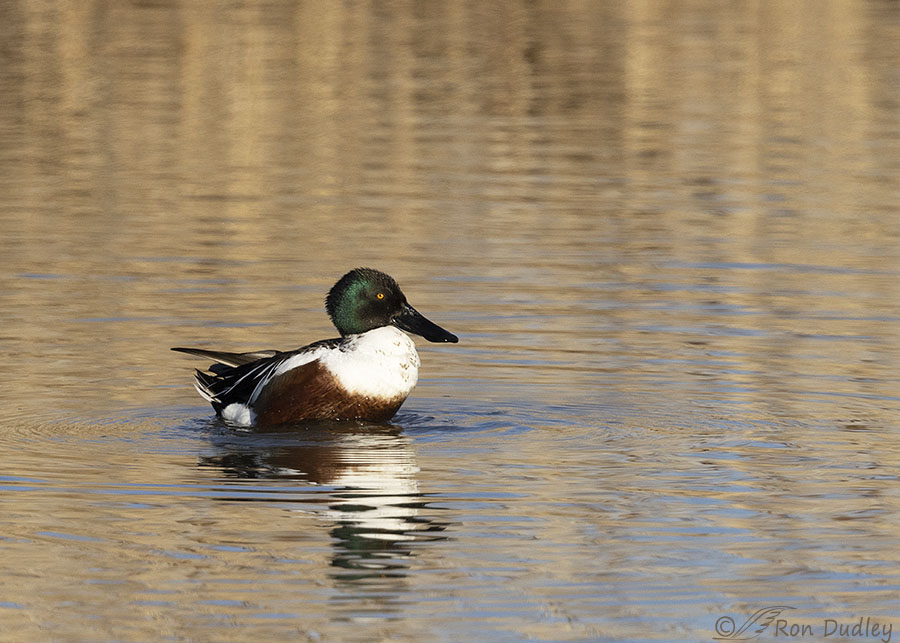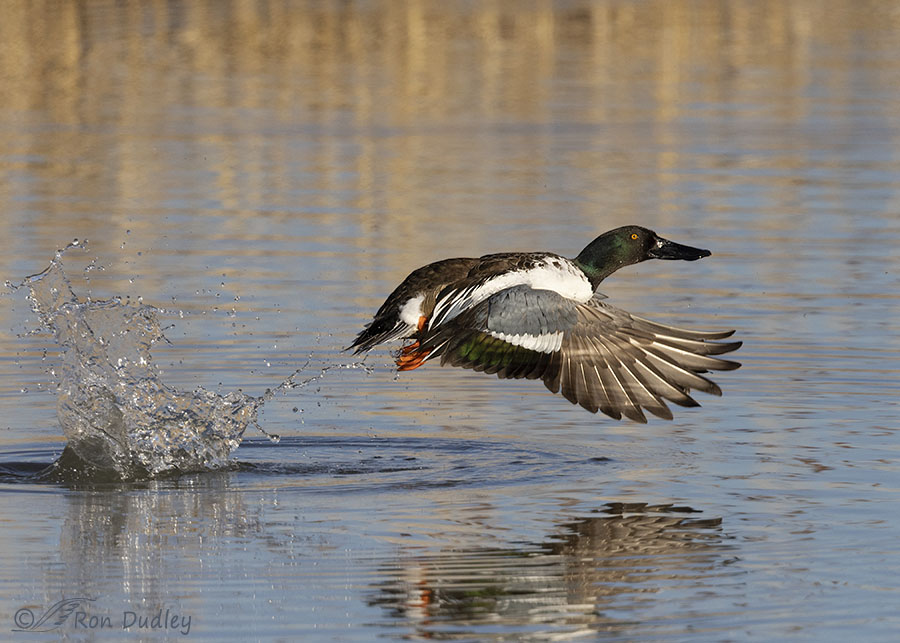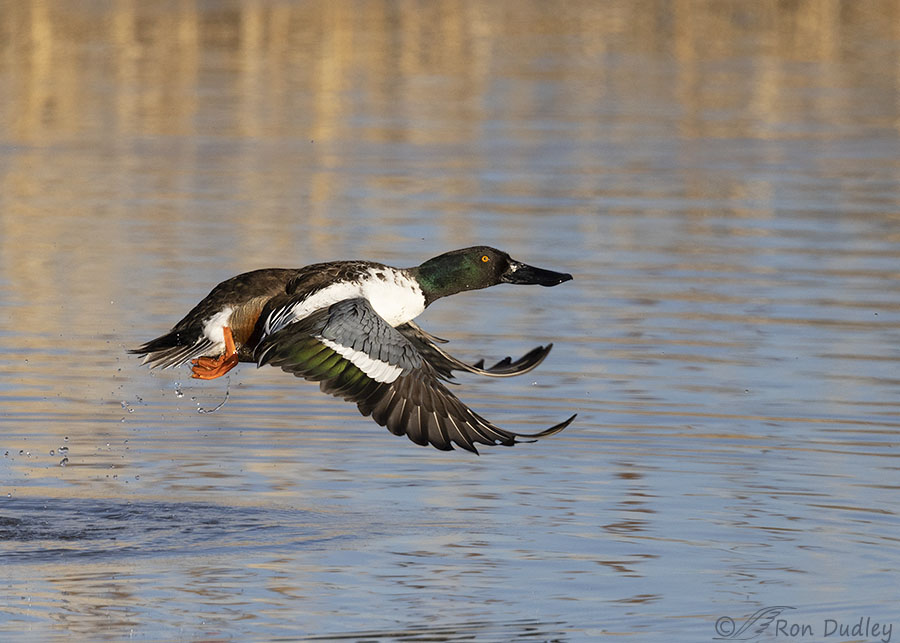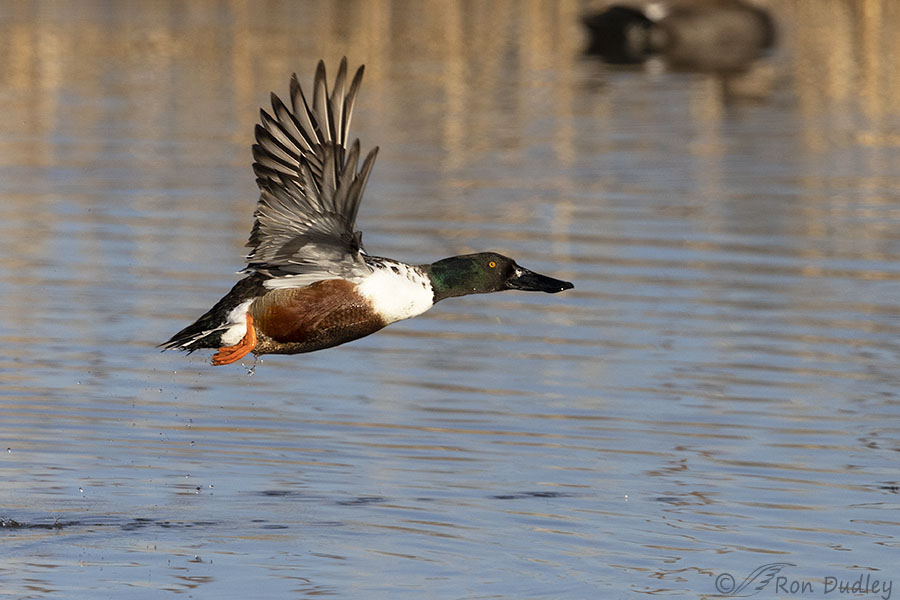Photographing ‘puddle ducks’ exploding off the water is always a challenge.

1/6400, f/6.3, ISO 800, Canon R5, Canon EF500mm f/4L IS II USM + 1.4 tc, not baited, set up or called in
Yesterday morning at Bear River MBR this male Northern Shoveler was at just about the right distance from me for takeoff shots so that was my goal.
When photographing ducks taking off it helps to know if they’re puddle ducks or diving ducks because that little bit of knowledge makes it easier to keep them in the frame. Diving ducks have to run horizontally across the water to build up speed to take off but puddle ducks spring directly into the air instead of pattering across the water. So with puddle ducks like Northern Shovelers it’s easy to not leave enough room for them at the top of the frame as they gain elevation.
This guy surprised me a little. This first photo was taken at the end of a rouse when he rose up off the water to shake his body so in this shot he’s settling back down into the water. Normally I wouldn’t expect him to take off immediately after a rouse.

1/6400, f/6.3, ISO 800, Canon R5, Canon EF500mm f/4L IS II USM + 1.4 tc, not baited, set up or called in
But that’s exactly what he did so I was a nanosecond slow on the trigger to get him before he completely left the water. I’ve cropped this photo to include the water splash he left behind.

1/6400, f/6.3, ISO 800, Canon R5, Canon EF500mm f/4L IS II USM + 1.4 tc, not baited, set up or called in
Except for the curve of his wingtips the next shot in the burst caught him in a flight posture similar to the one in the previous photo.

1/6400, f/6.3, ISO 800, Canon R5, Canon EF500mm f/4L IS II USM + 1.4 tc, not baited, set up or called in
Two shots in the burst later I finally captured him with his wings up. Wouldn’t you know, there’s a couple of photobombing coots at the top of the frame. I could have erased them from existence but chose not to.
I got other photos of him after this one but guess what? I didn’t leave enough room at the top of the frame for a composition that works for me so I’m not including them. At the time I was thinking more about the idiosyncrasies of my new camera than I was about him being a puddle duck that would jump directly into the air instead of running across the water’s surface.
I need to practice what I preach.
Ron


Ron,
You may be battling with the R5 but I can assure you that we in the blogosphere are enjoying the results. Many of us have noticed that previous mount lens work even better with an adaptor on the new mirrorless models and your recent postings have certainly been sharp.
This series of the Northern Shoveller are superb and irrespective on your thoughts on the AF, are demonstration of your considerable skills as a photographer. Well done.
Much appreciated, Gary.
Yet another delightful series. Puddleducks versus Diving ducks was new to me too. Thank you.
Thanks, EC. I’m always happy to learn I’ve provided something new and interesting to my readers.
Looks like the blast-off photo is a popular one. My question is: are those light horizontal stripes on the right primaries a reflection of the water ripples?
Like Everett, didn’t know about dabbler vs. diving duck takeoffs. Thanks for that.
Lyle, those white stripes are the rachis or shaft of each individual flight feather.
The lines I’m referring to are perpendicular to the rachises.
If they’re the lines I think you’re referring to they’re reflections off of the water, as you suspected.
Not to pry but could you list the idiosyncrasies you have encountered with your new camera system to which you refer? I am thinking about matching your setup as I did your last setup and want to know what you are thinking this far into ownership. Thanks!
Art, just providing a list would be woefully inadequate. Many items need explanation to make sense. So I hope to publish a post in the near future that will provide my impressions, pros and cons, of the R5. Stay tuned.
For now I’ll just say that at this point I think the pros significantly outweigh the cons.
Very nice series. I was going to go out today but when the alarm went off just couldn’t do it. Yesterday had me working a few hours and running all over northern Utah in my car. I have a hard time sitting for long periods driving and two days in a row turns me into a sitting statue. I don’t work the remainder of this week or at all next week with schools in spring break, so I hope to get out for photos and get the peach tree trimmed while the weather is good. Maybe I will run into you in the field.
I hope you manage to get out several times, April. And that we run into each other.
Excellent series, Ron. Enter my vote for image 2 as well-love the water splash. BTW, practicing what one preaches is easier said than done. I suffer from the same issue in my photography!
Stephen, I do a lot of my “preaching” to myself, in an effort to help me remember what to do and what not to do in those crucial moments.
Your timing is far better than mine. I’m sure I’d go from the duck on the water right to an empty frame. I’m not sure I ever understood what a “puddle duck” was, except for Beatrix Potter’s heroine. Thank you for this morning’s education. And thank you for the photobombing coots — gotta love the little rascals.
I am with Marty again. I ‘might’ have caught a little bit of the bird as he cleared my screen, but doubt it.
I get more than my share of those “empty frames”, Marty. And this morning I added significantly to my collection.
I should have provided lists in my post of which species are puddle ducks and which ones are diving ducks.
I’m with Michael and Arwen– I think that dynamic splash in shot #2 is a
wonderful addition– he looks “jet-propelled”, and the rest of the image
is crystal clear and “snappy”, too !
Kris, that shot is my favorite of the series. Looks like I’m not alone.
Beautiful and fun. Wouldn’t be so much fun if they did exactly what they’re supposed to do.
Wouldn’t be so much fun if they did exactly what they’re supposed to do.  Distraction of settings will, no doubt, be an issue for “awhile”…… Always love the bill that seems “so large” for them tho it certainly does what it’s designed to do.
Distraction of settings will, no doubt, be an issue for “awhile”…… Always love the bill that seems “so large” for them tho it certainly does what it’s designed to do.
Snow geeze have arrived at Freezeout. Unfortunately, there isn’t much water and most of it frozen….. Big Sag in our neck of the woods is pretty dry unfortunately.
Big Sag in our neck of the woods is pretty dry unfortunately. 
Judy, I’ve heard a lot of stories about Snow Geese at Freezeout but even though I lived close to there for many years I’ve never been there.
Neither have I for that……..
Love me a shoveler! Good ol’ boot lip himself. In photos 2-4, is that a reflexion on his bill, or a discoloration?
Shane, I believe it’s a reflection from his wet bill – what photographers call a “specular highlight”.
Love the second shot. Water frozen in time is always fascinating and beautiful. The fact it is associated with a bird in flight makes it all the more so.
Thank you, Michael.
The second shot looks as if the water has propelled the duck up and out.
Yup, it sorta does Arwen.
Very interesting and beautiful series Ron. I was not aware of the difference in their takeoffs. Guess I never paid that much attention. The migration seems to have really picked up. I was taking photos of a handsome recently arrived Ring-necked Duck yesterday and also noted the arrival of Redheads and Eared Grebs etc. Our Northern Pintalis are gone and the Norther Shovelers seem to be greatly thinning out. Both are probably already arriving there in Utah. Laughing at your photo-bombing Coots. Half the time I was just clicking a photo of the Ring-necked a Coot would swim into the photo.
Thanks, Everett. No other bird photobombs my images more than those damn coots. It isn’t even a horse race.
Here is the question that arises from your post. Do you think you would have even gotten the photos you did if not for the improved AF of the new camera?
Douglas, the answer to your question is complicated. Let’s just say that I probably wouldn’t have gotten all of these photos if I’d been shooting with my old camera – but it wasn’t improved AF that made the difference, not in this particular instance.
I hope to answer your question more fully and provide my overall early impressions of the R5 in an upcoming post.